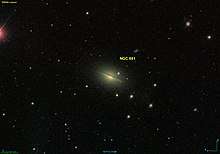NGC 681
NGC 681 (also known as the Little Sombrero Galaxy) is an intermediate spiral galaxy in the constellation of Cetus, located approximately 66.5 million light-years from Earth.[1][2][4] The name Little Sombrero Galaxy is a reference to a much larger and earlier observed sombrero-like galaxy designated M104, or the Sombrero Galaxy.

| NGC 681 | |
|---|---|
 SDSS image showing neighbours | |
| Observation data (J2000 epoch) | |
| Constellation | Cetus |
| Right ascension | 01h 49m 10.829s[1] |
| Declination | −10° 25′ 35.13″[1] |
| Redshift | 0.00587 ± 0.00002[1] |
| Helio radial velocity | 1760.4 ± 6.6 km/s[1] |
| Distance | ~66.5 million ly (20.39 ± 1.45 Mpc)[1] |
| Apparent magnitude (V) | 12[2] |
| Characteristics | |
| Type | SAB(s)ab |
| Mass | 1.9×1010[3] M☉ |
| Mass/Light ratio | 3.6[3] M☉/L☉ |
| Size | ~29.07 kpc (diameter)[1] |
| Apparent size (V) | 2.70 × 1.8 arcmin[2][4] |
Observation history
NGC 681 was discovered by the German-born British astronomer William Herschel on 28 November 1785 and was later also observed by William's son, John Herschel.[2] John Louis Emil Dreyer, compiler of the first New General Catalogue of Nebulae and Clusters of Stars, described NGC 681 as being a "pretty faint, considerably large, round, small (faint) star 90 arcsec to [the] west" that becomes "gradually a little brighter [in the] middle".[2]
Physical characteristics
The Little Sombrero Galaxy shares many structural similarities with its namesake, M104, although it is smaller, less luminous, and less massive. Its thin, dusty disc is seen almost perfectly edge-on and features a small, very bright nucleus in the center of a very pronounced bulge.[5] Distinctly unlike M104, NGC 681's disc contains many H II regions, where star formation is likely to be occurring.[3][5] The galaxy has a mass of 1.9×1010 M☉, a mass-to-light ratio of 3.6 , and a spiral pattern which is asymmetrical.[3]
References
- "NGC 681 NASA/IPAC Extragalactic Database Results". ned.ipac.caltech.edu. Retrieved November 2, 2018.
- "New General Catalog Objects: NGC 650 - 699". cseligman.com. Retrieved November 2, 2018.
- Burbridge, E. M.; G.R., Burbridge; Prendergast, K.H. (1965). "Rotation and Mass of the SA Galaxy, NGC 681". Astrophysical Journal. 142: 154–159. Bibcode:1965ApJ...142..154B. doi:10.1086/148270. hdl:2060/19650010085.
- "Revised NGC Data for NGC 681". spider.seds.org. Retrieved November 2, 2018.
- Faber, S. M.; Balick, B.; Gallagher, J. S.; Knapp, G. R. (1977). "The neutral hydrogen content, stellar rotation curve, and mass-to-light ratio of NGC 4594, the "Sombrero" galaxy". The Astrophysical Journal. 214: 383–389. Bibcode:1977ApJ...214..383F. doi:10.1086/155260. ISSN 0004-637X.